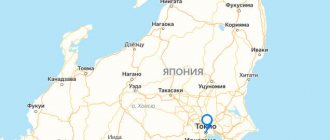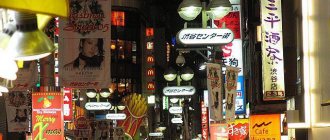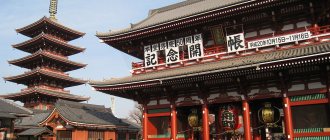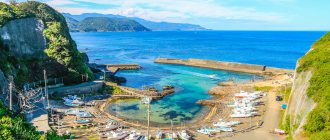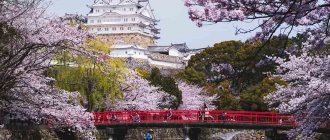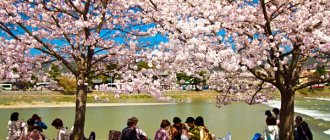How much does it cost to fly to Japan?
It is usually more profitable to fly abroad from Moscow. However, with Japan it’s different: the cheapest tickets are from Yuzhno-Sakhalinsk and Vladivostok (from 11,000 rubles), as well as Khabarovsk and Vladivostok (from 13,000 rubles). You can fly to Japan relatively inexpensively from Irkutsk - from 17,000 rubles, Petropavlovsk-Kamchatsky (from 18,000 rubles) and Novosibirsk (24,000 rubles).
The cost of a direct flight from Moscow to Tokyo is from 36,000 rubles, with a transfer – from 30,000. Ticket prices from St. Petersburg start from 33,000 rubles.
Where to find cheap tickets? Use the search engines Aviasales and Skyscanner - they compare prices of all airlines. Learn the secrets of finding cheap air tickets.
Japan visa cost
To travel to Japan from Russia you need a visa. Good news: the rules have been simplified, and Russians no longer need a guarantor to get it! But citizens of the CIS, alas, need to look for a guarantor.
The visa is free if you apply for it yourself at a consulate or embassy. Only they are in Moscow, St. Petersburg and the cities of the Far East. Residents of other cities will have to pay visa centers for sending documents.
Japanese visa (Photo: Max Braun / flickr.com)
Hotel prices in Japan in 2021
We recommend looking for accommodation in Japan, from cheap capsule hotels to luxury ryokans, on Roomguru - it compares prices of different services.
- Capsule hotels in Tokyo cost from $16 per person.
- A double room in a guesthouse in Tokyo costs from $27 per night.
- In a 2* hotel - from $45 per night (for example, in Hotel Meigetsu).
- In a 3* hotel - from $55 (Hotel Mystays Asakusa-bashi).
- In a 5* hotel - from $100 (Tobu Hotel Levant Tokyo).
The cost of traveling to Japan will increase if you choose to stay in a ryokan , a traditional Japanese-style hotel. In ryokans, the floor is paved with tatami, instead of beds there are futons, and guests are given national slippers and robes. Sometimes there is an onsen - a hot spring. The cheapest ones in Tokyo cost $70-80 for two people, usually with a shared bathroom. Ryokans with a private bathroom start from $100. $150-300 – spacious ryokans with onsen in other cities of Japan.
Tip: In large cities it is not necessary to live in the center. The main thing is that it is close to the metro.
Find a hotel →
A ryokan is a traditional Japanese style hotel. (Photo: Espen Faugstad / flickr.com / Licensed under CC BY 2.0)
Income
Compared to the rest of Japan, income levels in Tokyo are significantly higher.
The average salary in Tokyo is approximately 325,000 yen (1,254,876 tenge) per month after all taxes and fees. Hourly earnings for cashiers or waiters in Tokyo are about 985 yen (3,800 tenge). The salary of a beginner specialist without work experience is from 200,000 yen (772,231 tenge). The Japanese cannot imagine their life without work, without a position in a large national company such as Toyota, Sumitomo, Mizuho. This job comes with perks, like lifetime employment, which means you no longer have to worry about status or finding a new job. Within a national corporation, you can rise through the ranks until old age.
The whole life of a Japanese revolves around work - the concept of vacation does not exist for him. If necessary, you can ask for a special day off, but this is not a rest, but an opportunity to complete urgent matters on a working day.
At first it seemed crazy, but then I realized that there was no need for a vacation. Japan ranks one of the first in the world in the number of public holidays per year, so once a month there are one or two days off, not counting Saturday and Sunday. You quickly get used to this work schedule, so my special days off during the year can be counted on one hand.
Food prices in Japan in 2021
Food in Japan is delicious, fresh and relatively inexpensive! Dishes are prepared from natural, minimally processed ingredients. Rice, noodles, seafood and meat are the basis of the diet. As in China, there is no language problem when ordering food: the cafe has realistic food models, and the menu has photos.
To correctly calculate the cost of a trip to Japan, you need to know the approximate costs of food. On average, breakfast will cost about ¥400-500 per person - about the same price as, for example, udon noodles with tofu, ramen, rice with curry. Tea or water is served free of charge. Some establishments serve breakfast combos for ¥300-400.
A hearty lunch or dinner in a cafe will cost ¥1000-1500 per person. And if you are used to eating a little, then for two! In general, in inexpensive establishments a dish costs on average 500-800¥, in a restaurant - from 1000¥.
You can have an unusual and tasty meal in a conveyor belt restaurant (kaitenzushi). You sit at a table, and ready-made dishes pass by on a conveyor belt. A plate with two rolls or sushi costs from ¥105. The price of a dish can be determined by the color of the dish. At the end, they count by empty plates. Tea and ginger - free and unlimited. Examples of restaurant chains: Sushizanmai, Kappa-sushi, Hamazushi, Sushiro.
Read more: Food prices in Japan >>
Street cafe in Tokyo (Photo: unsplash.com / @gluzman)
How to save money on food in Japan:
- In supermarkets from 20:00 or 21:00 there are 20-50% discounts on ready-made food or products whose expiration date is running out. Examples: Seiyu, Ito-Yokado, OK-mart.
- Buy a bento - a lunch box, lunch in a box. Inexpensive, convenient and very popular in Japan. Costs from 300 to 1000¥ depending on the filling.
- You can eat inexpensively in restaurants serving Indian, Chinese, Korean and other cuisines that are aimed at local residents.
- Tasty and cheap - in family restaurants.
- As a last resort, you can buy ready-made inexpensive food in 24-hour minimarkets (convenience stores) Lawson, 7 Eleven, Family Mart. However, it costs more there than in regular supermarkets.
A Japanese woman tries Russian sushi. What kind of rolls are not available in Japan?
If you want to reduce the cost of an independent trip to Japan, cook yourself. For example, breakfast and dinner, and have lunch in a cafe. Vegetables and fruits are expensive in Japan and are usually sold individually. Meat is also not cheap.
Here are the prices for food in stores in Japan in 2021:
- bread - 70-130¥;
- sandwiches - 180-350¥;
- milk (1 l) - 180¥;
- eggs (10 pcs) - 230-250¥;
- shrimp (1 kg) - 1000¥;
- scallops (1 kg) – ¥1000;
- potatoes (1 kg) - ¥390;
- tomatoes (1 kg) - 730¥;
- apples (1 kg) - 200-660¥;
- oranges (1 kg) - 580¥;
- beer - 80-200¥;
- ready-made salads - from ¥400;
- bento - ¥300-1000;
- sushi sets or rolls - ¥300-1500;
- desserts and pastries - ¥100-400.
Ramen (Photo: unsplash.com / @migmal)
How much to take with you
How much money you need to take with you in Japan and how much local currency you need to buy depends on the tourist’s plans. If you are economical, you can spend 10 thousand rubles (for a 7-day trip). But it is advised not to take money “back to back” - the optimal amount would be 20-40 thousand rubles in local currency.
The first cost in Japan that every tourist faces is transfer from the airport to the city. A Japanese taxi looks a little expensive - a trip from the airport to the center of Tokyo will cost 12 thousand rubles . A more economical way to get to the hotel is by train or bus, which will cost approximately 3 thousand rubles .
As for food, a tourist should not have a lot of expenses. Street food in Japan is cheap, for example, Asian noodles cost from 200 rubles . Lunch in a cafe won't hurt your pocket either - for two people the average bill is between one and two thousand. Prices for food in supermarkets are quite budget-friendly; if you cook it yourself, then you shouldn’t spend more than 700 rubles a day .
In Tokyo, travelers are offered a large selection of excursions that are quite inexpensive - from one thousand rubles. There should be no problems understanding the language, because you can purchase a tour with a Russian-speaking guide. A trip to popular Japanese hot spring baths is also not very expensive - from 1,500 rubles .
Prices for attractions in Japan
Look for interesting excursions on the Sputnik and Tripster websites. Individual and group, without crowds of tourists and in Russian.
In Japan, every prefecture, every city has its own wealth! We will focus on the sights of Tokyo. Here are the prices for some interesting places:
- Shinjuku Goen Imperial Park - ¥200;
- Ueno Zoo - ¥600 for adults, children - free;
- Tokyo National Museum - ¥620;
- Nezu Museum - ¥1000;
- Tokyo Tower - ¥1600.
- Hot springs (onsen) - ¥1500-2000.
Plus, there are a lot of things you can visit for free in Tokyo. These include the Imperial Palace (make an appointment in advance), Kaminarimon Gate "Thunder Gate", as well as some parks and temples.
Medicine in Japan is expensive. We advise you to pack a tourist first aid kit.
Imperial Palace in Tokyo (Photo: @alexlanting / unsplash.com)
Cost of transport in Japan
Subway and trains. It's difficult in Japan without a train. The main railway company is Japan Railways (JR). the JR Pass especially for tourists . It is valid only for visitors and is issued before traveling to Japan on the JR Pass website. The document will be sent by email. Then, in Japan, at a subway station, find the company counter and exchange it for the pass.
The JR Pass is valid for all of the company's transport: shinkansen, some subway lines and many commuter trains. This is a personalized document and cannot be passed on to others. The most important thing is that you cannot lose it, because the card will not be reissued. It is expensive: for 7 days - $264, for 14 days - $422, for 21 days - $542.
The cost of a trip on the Japanese subway depends on the zones into which subway lines are divided in major cities of the country. Trains run every 5 minutes, from 5:00 to 23:30, sometimes until midnight. The color of the carriage corresponds to the line it follows. The fare depends on the distance and city. For example, in Tokyo it ranges from ¥120-320 per trip. A 1-day pass costs ¥1000.
Buses are inconvenient for tourists, since the numbers and names of the routes are almost always written in hieroglyphs. On average, buses run from 7:00 to 21:00, but in some areas departure occurs earlier (from 5:30) and ends later (until 23:30). The cost of one trip by bus and tram is ¥220-420.
Taxis in Japan are not a cheap pleasure:
- landing - 580-720¥;
- for every 280 meters - 80¥;
- for every 135 seconds of inactivity - 90¥.
Better use the metro! In addition, from 23:00 to 6:00, taxi drivers drive at night rates with a 30% surcharge.
If you want to get from the airport to your accommodation by taxi, and the hotel does not provide a transfer, we recommend booking a car in advance with Kiwi Taxi.
Tokyo subway car (Photo: unsplash.com / @liamburnettblue)
Traveling to Japan on your own
Japan is one of those countries that everyone should visit in their life at least once and see with their own eyes everything that they had only heard about from others before. But Japan seems very far away, and traveling there is a difficult undertaking that requires a lot of preparation. In this post we will try to answer the main questions about traveling to Japan - how to get a visa, how much money you need, where to live and how to get around while traveling.
Obtaining a visa to Japan
There is still information on many websites on the Internet that it is difficult to obtain a visa to Japan and for this you will have to use the services of a special agency, but this is no longer the case! Under no circumstances should you pay any agency to obtain a visa! Visa to Japan is absolutely free! All that is required from you is a small package of documents, mainly confirming that you have a travel plan and the financial ability to do so.
Indeed, previously an invitation from a guarantor on the Japanese side was required, but from January 1, 2021, the rules for Russians have been simplified - now a tourist visa can be obtained without a guarantor.
What documents are needed for a tourist visa to Japan? It is best to check the latest information on the website of the Japanese Embassy in Russia. Let us highlight the main points relevant at the time of writing this post:
- the visa application form is downloaded from the Embassy website and filled out in English (or Japanese, if you know);
- photographs must be 45*45 mm in size, for Russia these are non-standard sizes, please pay the photographer’s attention to this;
- The Embassy website states that a document from work and/or a bank account statement is required as a document to confirm your financial capabilities. I would like to immediately say that instead of “and/or”, read it as simply “and”, because with a 99% probability both documents will be needed, and the bank statement has higher priority. Still, at work they can often draw any number, but at the bank they will only issue a certificate with reliable information about savings;
- There should be an amount in your bank account equal to approximately $100 per person for one day of travel. Budget tourists may be satisfied with much more modest amounts (especially if there is a friend in Japan who will provide housing and food), so you can simply deposit the required amount into your account to obtain a certificate, and then withdraw everything unnecessary again and, for example, buy plane tickets with this money;
- Many people have a question about what to write in the program of stay. Write exactly what is written on the embassy’s website: cities, addresses of hotels (or other places where you plan to stay) where you will stay, as well as proposed transfers and trips. There is no need to plan out all your movements hour by hour.
In general, there is nothing difficult in obtaining a Japanese visa. Collect documents, submit them to the embassy and receive a passport with a visa - that’s all. The minimum period for reviewing a visa application is 4 days , but as practice shows, in most cases you don’t have to wait longer. The website of the Japanese Embassy in the Russian Federation is your best friend while obtaining a visa; all the necessary information is collected there.
How much money do you need to travel to Japan?
Before moving on to a detailed description of a possible trip to Japan, let’s immediately deal with the main question - how much money it will require. Still, to start planning a trip, you need to be sure that you can afford it.
So, if you want to go to Japan for 7 days and at the same time want to live in comfortable conditions, indulge in local delicacies and visit museums and attractions, then you will need approximately 128 thousand rubles.
What does this amount consist of:
- Flights . Round-trip tickets departing from Moscow will cost an average of 30-35 thousand rubles if you buy in advance and look at different dates. When flying from the eastern part of Russia (for example, from Irkutsk), you can find round-trip tickets costing up to 20 thousand rubles, so for Siberians a trip to Japan may be cheaper.
- Accommodation . In Tokyo, a night in an average hotel will cost 4-6 thousand rubles. For a week this is 28-42 thousand rubles. Yes, the spread is decent and it is recommended to focus on the upper limit of this fork. This amount usually includes breakfast. Naturally, you can find both cheaper and more expensive options, but now we are looking at the middle option, balancing between comfort and efficiency. For this money you will get exactly a hotel room, with its own amenities and regular cleaning. Hostels and guesthouses will cost much less, but not all tourists agree to such modest accommodation.
- Subsistence . Without particularly denying yourself delicacies, you can spend an average of 2,000 rubles per person on food every day. For a trip this is about 14 thousand rubles for food. There is no upper limit, but in this regard we are assuming that you eat the standard 3 times a day of regular Japanese food.
- Transport . A subway pass in Tokyo will cost approximately 550 rubles per day. And for traveling around the country, it is better to purchase a special JR Pass; for 7 days it costs about 15,500 rubles. Read the post further, we will consider the issue of transport in Japan in more detail.
- Museums, attractions and small pleasures . Count on 3000 per day. That is, you need to take about 21 thousand rubles for the trip.
So it turns out that in just 7 days in Japan you will have to leave approximately 128 thousand rubles. Note that a significant portion of the cost is plane tickets, so it may be better to go for a longer period (eg 10 days or 2 weeks). True, this will require additional financial costs... On the other hand, sacrificing comfort and convenience, you can greatly reduce the total cost (up to 2 times if you agree to live in the cheapest hostels!). It's up to you to decide!
Housing in Japan
In fact, there are no big issues with accommodation for tourists in Japan - just like in any other country, we go to a hotel website (for example, booking.com) and look for something that suits your requirements and wallet.
It is only worth noting that on average, hotel rooms in Japan are slightly smaller than in Russia or Europe. For example, there is a chain of APA business hotels - the rooms there are usually exactly the size to accommodate a bed, a TV, a small bedside table and a narrow corridor to the toilet with a shower and a door. On the other hand, people usually don’t go to Japan to spend time in their hotel room...
In addition to regular hotels, there are hostels and guesthouses, where you have to share a room with other people, but the prices are much lower.
There are also traditional Japanese hotels called “ryokan”. In a ryokan, you will live in a traditional Japanese room with natural tatami flooring, eat traditional Japanese food at low tables and sleep on futons, traditional Japanese mattresses that are laid out directly on the floor, and during the day they are put away in a sliding wardrobe in the wall (this is done by the ryokan workers ). Ryokans also usually have hot springs where you can soak and relax. Ryokans are more expensive than standard hotels, but it is worth it if you go to a ryokan that is located somewhere in nature. And get ready for the fact that traditionalism may be at such a level that you will begin to miss more modern comfort. However, it’s definitely worth spending a night or two in the ryokan!
In addition to hotels, you can take advantage of offers on Airbnb. But in the spring of 2018, Japanese legislation became stricter, so 80-90% of the offers from the site disappeared. However, if you are traveling in a group of 5-6 people, then Airbnb accommodations will probably still be very profitable.
Getting around Tokyo and Japan in general
The main mode of transport in Japan is trains . This is true for the entire country, including the capital. The railway network is very extensive. This is the most reliable, fastest and affordable form of transport .
Below we will look at how to travel by train in more detail, but first, briefly about other types of transport and why you are unlikely to use them:
- buses - with such a developed and convenient railway network, it is not very clear why to use buses, because you will have to understand the routes, the location of stops and how to understand where this particular bus is going. That is, repeat for the second time what you will do with trains and the metro (and at first the abundance of information will knock you off your feet, rest assured). However, if you still decide to use the buses, then all the necessary information is described in detail on the Toei Bus website. In addition, it should be noted that there are night intercity buses - and they are already worth attention.
- taxi is expensive. Taxis are only suitable for wealthy tourists who don't mind spending thousands of yen even on fairly short trips. And in the case of long trips, the bills will already be tens of thousands of yen: for example, a taxi from Narita airport costs from 20 to 40 thousand yen (approximately 10-20 thousand rubles) depending on the area where the destination is located; from Haneda Airport, which is located closer to the city (administratively and completely within the city), is slightly cheaper - from 11 to 17 thousand yen (5.5-8.5 thousand rubles). By comparison, the Keisei Limited Express, which departs from Narita every 20 minutes, costs just 1,190 yen. And from Haneda there are trains on the Keikyu Line, which will take you to the center of Tokyo for about 600 yen. In short, a taxi is an option for exceptional cases when you cannot do without overpaying tenfold! Uber in Japan is underdeveloped, available only in central Tokyo and prices for trips are not much different from the prices for a regular taxi.
- Airplanes - There are many airports throughout Japan with domestic flights between them. For tourists, there are special tickets from Japan Airlines called JAL Japan Explorer Pass, which cost much less than standard ones - about 10 thousand yen for a one-way flight on the longest flights (see details on the website). When flying from Tokyo to the northern island of Hokkaido or vice versa to the southern islands of Okinawa, this can be advantageous because standard tickets cost 2-3 times more. However, these places can also be reached by high-speed Shinkansen trains, which are available with an unlimited JR Pass. Perhaps planes will allow you to gain a few hours due to the speed of the flight, but keep in mind that it usually also takes quite a long time to get to the airport, and you need to arrive in advance to go through check-in and drop off your luggage, and upon arrival you will have to wait for your luggage to be collected, while trains depart from the city center and do not require any preliminary procedures. Plus, if you've already bought a JR Pass, then splurging on planes even at relatively low prices probably doesn't look very attractive.
So, now it should be clear that moving around Tokyo and the country occurs mainly by subway and trains. This is a very branched, complex system, in which it is easy to get confused at first, so let's figure it out.
Rail transport in Japan
Firstly, Tokyo's railway network consists of lines that are owned by different companies. What does this mean for you as a tourist? This explains the abundance of different symbols on the metro map, and also for this reason the JR Pass does not cover all lines. There are lines of the state-owned Japan Railway (JR Lines); they can go far beyond the city limits and are connected to a network throughout the country, and they are covered by the JR Pass (meaning you can ride on such lines for free with a JR Pass). There are subway lines called Tokyo Metro. There are also separate private lines and a separate automatic monorail line to Odaiba Island (Yurikamome Line). At large stations you can often make a transfer between several lines, including between lines of different companies (for example, you can transfer from the JR line to the metro line without leaving the station, but simply moving to another platform).
Secondly, unlike the Moscow metro in Japan, the fare depends on the distance between stations . A trip to 1-2 stations will cost about 170 yen, but a trip from one end of the city to the other can cost 300 yen or more. If you bought a ticket of an inappropriate denomination, you can pay the required difference or get change from special machines with the inscription Fare Adjustment or from a station employee if there is no such machine (an exceptional case).
Thirdly, it is important to know that need to keep your ticket for the entire trip , because at the exit you will need it again - the turnstile will not let you out without a ticket! If you purchased a regular one-time ticket, then after passing through the entrance turnstile it will come out from the back. Don't forget to pick it up. If you forgot your ticket at the entrance turnstile or lost it, contact a station employee, he will tell you what to do.
What tickets are there for trains and subways in Japan?
Tokyo Rail Map
The Japanese rail transportation system provides an extensive list of different tickets and passes. Each traveler can choose the appropriate option depending on the length of stay in Japan, the number and distance of trips.
Single tickets
The simplest option. Such tickets can be purchased from special machines at any station. As already mentioned, the longer the distance, the more expensive the trip will cost. You can find out the price by checking the map, which is always located next to the ticket machines. If you can’t find out how much your trip will cost, then feel free to buy the cheapest ticket, because you can always pay the difference at the exit at a special machine with the inscription Fare Adjustment. If you are planning only a few trips on the metro, then regular single tickets should be enough for you.
Unlimited daily passes
If you have planned to visit a couple of museums in different parts of the city in the morning, want to go to the zoo in the afternoon, then immediately take a walk through the Imperial Park, and spend the evening in the bright lights of the Shibuya intersection, then, obviously, you will actively use the subway. In this case, it is very profitable to buy a day pass - it allows you to travel unlimitedly for 24 hours.
Day passes are also different. Firstly, they are divided into those that need to be used on the day of purchase, and those that can be bought in advance and used any day within 6 months.
A one-day pass, which must be used on the day of purchase , can be purchased at any station from a machine and must be used at least once before the last train leaves on the same day. Otherwise it will become invalid. In this case, the pass is valid for 24 hours, starting from the first trip (that is, it will be valid for some time until the next day if you used this pass for the first time late in the evening).
The one-day pass, which can be purchased in advance , is only sold at selected major stations. Its difference is that from the date of purchase you have 6 months to use it on any day. It is also valid for 24 hours, which starts counting after the first trip. Why such a ticket is needed when almost the same one-day pass can be bought at any station on any day is not very clear. But perhaps this is convenient for some situations, so it is better to know about this possibility.
The price for both types of one-day passes is the same.
Unlimited monthly passes
As the name suggests, these passes are best suited for those traveling to Tokyo for a long period of time. For example, for exchange students, language school students or trainees. If your trip will last about a month, then you should pay attention to this type of travel card. Unlimited monthly passes are also divided into two types.
The first type allows you to move around all metro stations without restrictions. A monthly pass costs about 17 thousand yen, that is, quite expensive, but if you plan to travel a lot over long distances, then it will pay for itself.
The second type of monthly pass allows you to travel only within a certain area. When purchasing this pass, you can choose any two stations, travel between which will be included in the price of the pass. In this case, the cost itself is calculated upon purchase. It turns out to be much cheaper than a monthly pass with travel to all stations and will definitely pay for itself if you travel along the purchased route 5 days a week, twice a day. Moreover, if you need to go to stations outside of the operation of the pass, then you will only pay the difference for the “additional” stations. This is done in the Fare Adjustment machine.
Japan Rail Pass: what it is, where to buy and how to use it
JR Pass is a special travel pass from the largest Japanese railway company, Japan Railways, which was designed specifically for tourists and allows you to save a lot on traveling around Japan by train. JR Pass can only be purchased by tourists and only outside the country! This pass is not available to Japanese citizens and residents.
You can purchase a JR Pass only from authorized sellers - in Russia, for example, JTC and Neotour. On the websites of both companies, prices are indicated in yen, so you need to check the price in rubles before purchasing. At the current exchange rate (2018), a JR Pass for 7 days will cost approximately 15.5 thousand rubles .
There are 3 types of JR Passes - for 7, 14 and 21 days. The only differences are in the validity period, otherwise all passes are absolutely identical - they all allow unlimited use of JR lines, including high-speed Shinkansen trains (except for some of the fastest Nozomi and Mizuho). Additionally, the JR Pass gives you free travel on select buses as well as the ferry to Miyajima Island (a popular tourist spot).
Outside Japan, you purchase a voucher that must be exchanged for a travel pass upon arrival in the country. There are exchange points at airports, but there may be queues there, so it often makes sense to take an express train and get to one of the central stations, where vouchers for JR Passes are also exchanged. In Tokyo these are Tokyo, Ueno, Shinjuku, Shibuya, Ikebukuro and Shinagawa stations.
When using for the first time, you need to contact the employee near the turnstiles so that he can mark it. In the future, when using the JR Pass, you will simply need to show it to the station employee, no more stamps will be required.
It is recommended to watch this video from the Chepolinko channel, which tells in detail how the railway works in Japan, and also shows how to buy a subway ticket, how to use Fare Adjustment machines if you have traveled further than the paid distance, as well as what rules of conduct on Japanese trains:
We arrived in Japan - what next?
Japan has so much to offer, the country is rich in culture and has something for everyone. Some will be enchanted by the ancient thousand-year-old Buddhist and Shinto temples, while others will be delighted by the modern giant skyscrapers. Japan has a very diverse and at the same time exotic cuisine for us; there are many dishes there in addition to the familiar sushi. But even sushi in Japan is not at all what you are used to here, so this is a new experience that is worth trying.
This post will grow to infinity if you start listing what you can do in Tokyo, Osaka, Kyoto and other important tourist cities in Japan. These topics will definitely have to be covered in the future, but for now we can only hope that the information from this post has already allowed you to at least a little clarify some questions regarding your trip to Japan. Be sure to visit this country! Going there is not as difficult as it might seem at first glance, and emotions and impressions are guaranteed.
